THE OAK-PINE FOREST
OF BAHUICHIVO
October 12, 1996
Notes from a birding trip
through Mexico by Jim Conrad
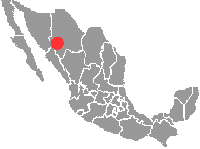 One
of the most awe-inspiring railroad tracks in the world runs between Creel and Topolobampo
on the Pacific Coast. With 39 bridges and 87 tunnels, and ranging from 2,417 meters(8,056
feet), to sea level, this stretch of the Chihuahua-Pacifico Railway passes through a
rainbow of ecological zones, from Creel's cold, high-elevation forests of Arizona Pines to
Topoloampo's tropical beaches. In Creel, when I board the train headed westward,
downslope, I ask the conductor for a ticket to the first town surrounded by forest in
which oaks appear among the pines. To my vast surprise, without a single comment or wry
look, the enlightened man simply writes out a ticket reading: Bahuichivo.
One
of the most awe-inspiring railroad tracks in the world runs between Creel and Topolobampo
on the Pacific Coast. With 39 bridges and 87 tunnels, and ranging from 2,417 meters(8,056
feet), to sea level, this stretch of the Chihuahua-Pacifico Railway passes through a
rainbow of ecological zones, from Creel's cold, high-elevation forests of Arizona Pines to
Topoloampo's tropical beaches. In Creel, when I board the train headed westward,
downslope, I ask the conductor for a ticket to the first town surrounded by forest in
which oaks appear among the pines. To my vast surprise, without a single comment or wry
look, the enlightened man simply writes out a ticket reading: Bahuichivo.
At first the track courses through pine forest and keeps to more or less
level ground and there is no hint of what the map shows as reality: That we are actually
coursing along the top of a large peninsula of highland jutting out southwestward into the
Pacific lowlands. Eventually we do break from the forest and it comes as quite a shock.
We're gazing blankly through the windows as pine and more pine blurs by and then instantly
our car rumbles onto a dizzyingly high bridge spanning a vertical-sided abyss. Then just
as suddenly we're back into the somber pines.
This happens several times. Sometimes from the bridges we can see
that the canyons being crossed are just arms of the much larger Copper Canyon, the
northern rim of which the train's track is paralleling. The view into Copper Canyon is a
panorama of enormous gray walls of exposed edges of horizontal rock strata and jagged rock
chimneys with bonsai pines atop them. But distances and dimensions in these views are so
otherworldly that it's impossible to sit in a train and relate to them. The views are like
images flashed on walls and it's hard to believe we're right at the edge of something so
immense.
A couple of hours out of Creel, the map indicates that the highland
spur is about to come to an end. The track crosses a narrow ridge, careens over a canyon
wall and descends, not to ascend again. Within ten minutes we've lost enough elevation for
oaks to appear among the pines, and right on cue the wonderful conductor appears.
"Ya llegamos," he tells me; "We're
arriving."
CHIMNEY ROCK
Bahuichivo is dinky and mud-splattered, not much more than a train
station and a sawmill. Coming into town I'd noticed a fine camping spot along a pretty
stream upslope so I hike back along the track. After about an hour I find the location.
It's a perfect camping spot in every respect except one: Now that I think about it,
probably the dozen or so local men lounging around the station as I hiked out of town
could guess exactly where I was heading with a backpack. And that sets me up for being
robbed. A few years ago in Durango not far south of here a couple of fellows near a
sawmill town just like this one knocked on my tent one night and when I peeped out they
put a pistolo to my head and took everything...
With a twinge of regret I cross the parklike opening along the
stream and head up a slope so steep that I must draw myself upward by pulling on the very
dense, shrubby undergrowth. The elevation here is about 680 meters lower (±2230 feet)
than Creel, so it's warmer than I've experienced for a few days. However, it's still about
1650 meters high here (±5,400 feet), so it's not long before I'm very sweaty, and gasping
for air.
Often I must rest, usually straddling a small tree trunk to keep
from sliding downslope. With sweat burning my eyes and my shoulder muscles searing from
lugging the backpack, I think about my fears, about the possibility that with this white
beard and balding head I should really be somewhere else this dusk, doing socially
acceptable things, not slinking about in such a shape, in a nameless Mexican canyon.
After twenty more minutes of looking I still haven't found a spot
level enough for a tent, or even for simply lying down in a blanket, and it's almost dark.
I'm near the slope's top, at the edge of the vertical rock cliff forming the canyon's
upper wall.
Then through the undergrowth I spot a chimney rock about ten meters
high (thirty feet) rising next to the cliff face. I make my way to the gap between the
chimney and cliff, remove my backpack and tie a rope to it, then with my back to the cliff
walk my way up the crack between the cliff wall and the chimney, and when I'm atop the
chimney pull the backpack up after me. I lie there wet with sweat until my breathing slows
down.
The chimney's summit is just large enough to park a car on. It's
occupied by one medium-size pine and a small oak, and there's a more or less level spot
just big enough for the tent, right at the pine's base. The view into the valley is
fantastic. I'm right even with the treetops that are bound to be filled with birds in the
morning, and from here I could hold off a large band of banditos. Barely with
enough light to see what I'm doing, I stake the tent, enter it and feel very lucky indeed.
UNSEEN SINGERS
At dawn, inside the tent there is no sensation that I am atop a
chimney rock. I could as well be awakening in the middle of a vast grassland, on the muddy
banks of the Mississippi, or back in Belgium, where I was living just a month ago. That's
a lovely thing about tents: Though you may awaken in a different spot every day, inside,
it's always the same, and the homey familiarity is comforting. My tent with its known
splotches of mildew on the ceiling and ant-gnawed holes in the floor is someone else's
homey breakfast table and kitchen-window curtains.
It's not as bitingly cold here as it was during dawns at Creel.
Through a slit in the tent I retrieve the thermometer left leaning against the pine's
trunk. Here in the middle of October, at an elevation of about 1,650 meters (5,400 feet),
some two-thirds of the way up the western slope of the Western Sierra Madres, it's 8° C
(47° F). Worming my way outside, I cocoon in a blanket, lean against the pine's trunk,
and look around, listening for birds.
Almost instantly the first bird-call of the day sounds, one of my
favorites.. From among a jumble of boulders along the cliff's base at the canyon's head
arises the piercing, liquid call of the very wren to be expected here, the Canyon
Wren. It's a brown and rusty-colored little bird with a pure white throat and
chest.
The song, to my ears, is exactly like a whistled rendition of
someone laughing so hard that their last laughs trail into gasping heaves. But what makes
the song beautiful is that usually, as is the case here, rocky backdrops create an
acoustical situation that amplifies and projects the song-laugh. It seems impossible that
a bird only 11.5 centimeters (±4.5 inches) can be responsible for such a resounding call.
Then another birdcall, also from the canyon's head, and this one
represents an important milestone in our trip! It's the call of a Brown-backed
Solitaire, and this is the first species encountered on this trip that is not
also found in the United States. For the first time a species we've listed is one not
illustrated in North American field guides. Here in the southwestern corner of Chihuahua
we are at the northwestern extreme of its distribution. From here it ranges south through
the Mexican mountains, to Guatemala, El Salvador, and Honduras.
Solitaires, along with thrushes and bluebirds, are members of the
Thrush Family, the Turdidae. Except for their longer tails, they are similar to
the mousy, look-alike species of flycatcher that have been giving me so many
identification problems. They are exceedingly plain-looking creatures. The thing about
solitaires is their song. Many would say that they are the champion singers of all Mexican
birds. Well, it is often the case that the most plain-looking birds are the best singers,
and this may be the best example of that. Sadly, this bird is often sold in Mexican
markets, even though its song from a cage is nothing to be compared to what I hear here.
The song begins innocently enough with a soft wenk, wenk,
and then metamorphoses into a chortling jumble of flutelike notes ascending the musical
scale with ever increasing velocity. The older bird books say that the song suggests the
cranking up of an old-time motor car.
ATTACK FROM ABOVE
For an hour the pines and rock outcrops rimming the canyon glow in
sunlight and the blue sky dazzles with its clarity, but the canyon itself remains chilly,
shadowy, and somber. At mid morning, still in the shadows, warm breezes begin stirring.
Hot air is supposed to rise but, here, air feeling warm and dry and smelling of pine
appears to be draining from the canyon's head and flowing down the canyon, streaming
around the chimney rock and me. And this strange wind is bringing me visitors...
They are stink bugs. Brown, shield-shaped
hemipterids of the family Pentatomidae, hoards of them, not lazily drifting with
the warm currents, but flying hard with the current, as if embarked on stink-bug kamikaze
missions. They thump into the tent, against the pine, and against me, my legs, chest, and
face. They roll to the ground, flounder struggling to get upright, and if their flailing
legs happen to snag something they yank themselves onto their bellies and immediately fly
off again. Soon the ground is littered with them and if I nudge one with a finger the
finger ends up smelling like the nauseating stinkbug defense.
No sooner has the invasion subsided than another onslaught begins,
this time conducted by black, plump, two-millimeter-long (±1/12th inch), blood-sucking black
flies -- Dipterids, probably of the family Simuliidae. They swarm around
ankles, arms, neck, and face, and do not diminish in numbers once sunlight arrives. They
become a plague with repellent keeping them away only a few minutes. Atop my chimney, as
the canyon at last receives its full share of sunlight, I sit fuming over the godly humor
that sets a mind so acutely alert and informed in a body that, by virtue of its very
nature, draws black flies that make elevated thought impossible.
TREETOP VISITORS
With the sunlight's arrival, birds begin stirring at eye level in
the treetops around me. First a hummingbird comes out of nowhere, hovers right before my
face, contemplating the tip of my nose. Before I can overcome my surprise and begin
registering its features, it's off, and will not appear in the Official List.
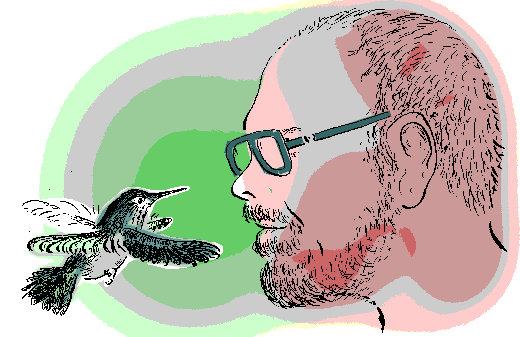
Ten minutes later a flycatcher lands in a pine snag a mere
car-length before me, in full view in bright sunlight, and silently perches in profound
nondescriptness long enough for me to figure out, mostly by comparing habitat and
distribution remarks of all the look-alike flycatchers, that it's probably a Buff-breasted
Flycatcher. However, it might also be a Western Flycatcher. I
told you about these flycatchers. Neither of these names will appear in the Official List.
To read about
another of my experiences with "Mexican Jays,"
click
here.
Then five Gray-breasted
Jays, called Mexican Jays in older books, rampage over the rim of the cliff
above and settle in the treetops around me. Gray-breasted Jays are about the size of North
America's Blue Jays and Steller's Jays, and they also are predominantly blue. The big
difference between them is that Gray-breasted Jays are crestless.
There atop the chimney rock it's as if I were perched among them.
Wrapped in my blanket more against black flies than because of the cold, I'm struck by how
alert each bird seems, constantly glancing around, and how vivacious and subtle their
interactions are. Silent and unmoving inside my blanket, I feel like a mud-caked turtle
watching a flurry of butterflies.
Sometimes jays are described as "nature's alarm system"
because they tend to be drawn to any commotion or deviation from the norm. When disturbed
they cluster around the object of concern disturbing the neighborhood's peace with shrill,
grating, cawlike calls. One endearing feature of Gray-breasted Jays, however, is that
their voices are not nearly as harsh as their northern relatives'. Gray-breasted Jays fly
about asking in fairly civil terms, Wink? Wink? Wink?.
One jay in the flock carries a small acorn onto a branch of the
little oak next to me, wedges it between its feet, and with the same exaggerated seesawing
motion observed at Creel with the Mexican Chickadee, chisels at the acorn with its beak.
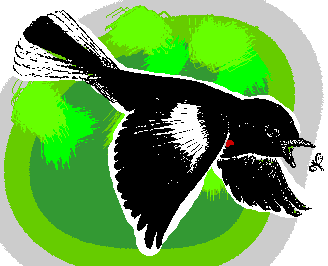
A Painted
Redstart flies out of the woods right at eye-level and exactly just a few
feet before my face snaps an insect from midair. He's so close that I see very plainly how
he closes his eye the moment he reaches the insect. I've never read this before but it
makes sense. If he misses the insect, the eye might be damaged. What a grand observation
post this chimney rock is!
So far all the birds seen here are species not observed at our
previous three stops. The pine and oak sharing the chimney-rock's crest with me likewise
are species not seen before, and I'm not sure what they are. Prickly-pear cactus clings to
vertical rock outcrops of the canyon wall. On the canyon's drier slopes stand juniper and Madrone
trees, as well as waist-high clumpgrasses. In the deepest, moistest, most shaded valleys
there are very tall, dark, stately fir trees.
Not everything here is new, though. Flitting among the pines, just
as they did among the mesquite in the grassland-mesquite zone, and among the pines at Lake
Arareko, are Yellow-rumped Warblers.
NORTHERN FLICKERS
A couple of Northern
Flickers forage for ants on the ground at the base of the rock cliff. I can't
see a flicker without thinking of a classic experiment. Adult male Northern Flickers bear
conspicuous "mustaches" like the one on the right in the picture at the right.
The mustaches are black in the Yellow-shafted race but red in the Red-shafted race, the
one we have here. Females do not have mustaches. Thus a female flicker was caught, a
mustache was painted on her, and her romantic life was utterly devastated.
Here's something else I think about when I see flickers.
Ornithologists distinguish between bird species that are "determinate layers,"
which lay a fixed number of eggs, and "indeterminate layers," who lay extra eggs
if some are removed from the nest early during the incubation period. Northern Flickers
are indeterminate layers. In fact, one flicker laid seventy-one eggs in seventy-three
days, trying to replace eggs removed as soon as they were laid.
LOOKING INTO TREES
For two days I remain atop the chimney rock, for seldom have I ever
enjoyed such a perfect perch level with treetops. It's good to be atop the chimney rock
when sunlight floods into the canyon. In afternoon wind my neighboring pine's branches
knock together and the dry rapping sounds travel down the limbs into the trunk, sounding
like heartbeats deep beneath the coarse, black bark.
When the wind is greatest, tree tops heave and leaves quiver
franticly, like children waving arms and wiggling fingers to get attention. When the
sunlight is brightest, I can see through several trees at one time, everything moving,
knocking, sighing, rustling, even whistling, and I am glad to be on the chimney rock right
inside the tree-top feeling.
Late in the afternoon of the second day I place my ear to the pine's
trunk and listen for a while to the heartbeat. Then hardly able to hear my own voice over
the wind-roar all around me I whisper into the bark that soon I must descend.
THE TROGON
Next day, down next to the stream but keeping away from the perfect
campground, a round boulder near the bank is perfect for clothes washing, and tree
branches hanging low over the stream are perfect for drying. After the morning's scrubbing
and hanging of clothes I sit on a boulder in mid-stream, staring blankly into deep shadows
pooled behind a sycamore along the stream bank. A pale spot among the sun flecks twitches,
and automatically my binoculars rise for a look. Silent and unmoving, an Elegant
Trogon -- called Coppery-tailed Trogon in older books -- perches gazing right
back at me.
Now, from a Northern birder's point of view, the five
"most exotic" kinds of Mexican birds are probably the tinamous; parrots and
parakeets; motmots; toucans... and; trogons. With their size, bright colors and stubby
tails, Trogons look a little like parrots, but they lack the parrot's sharply downcurved
beak.
The Trogon Family, the Trogonidae, is represented in the
U.S. only in extreme southeastern Arizona, by the Elegant Trogon, and, very rarely, the
Eared Trogon. Though some of the thirty-seven or so of the Earth's trogon species occur in
Asia and Africa, trogons are mainly tropical American birds, with nine species breeding in
Mexico.
The trogon before me now is behaving typically for trogons. They
like to perch in fairly secluded, hidden locations, remaining very still. This lifestyle
makes sense for trogons, whose main food is small fruits, with only occasional insects.
Thus their diet is not nearly as energy-rich as that of a pure carnivore or nectar sipper.
Trogons need time for fruits to work their way through lengthy intestines while enzymes
break down the fruits' complex carbohydrates. They grab a fruit, then sit quietly as it
digests.
Trogons have their own peculiar manner of "grabbing
fruit." They flutter up to a small fruit and without landing take hold of it in their
stubby, thick beaks, the upper mandibles of which are equipped with serrated edges. Not
letting go, and most likely "sawing" at the fruit's moorings with those serrated
mandible-edges, they simultaneously let the momentum and weight of their chunky bodies
help them snap the fruit from its point of attachment. It all happens very quickly. Within
five seconds a trogon can leave its perch, acquire a fruit, and then be back on its perch
placidly digesting.
Most birds have four toes directed forward, with one toe pointed
backward. A few, the best known of which are woodpeckers and parrots, have zygodactyl
feet, on which two toes are in front and two behind. On normal zygodactyl feet the first
and fourth toes are directed backward. However, there is one bird family in which the
first and second toes are directed backward, not the first and fourth. This is the trogon
family. The special word characterizing trogon feet is heterodactyl.
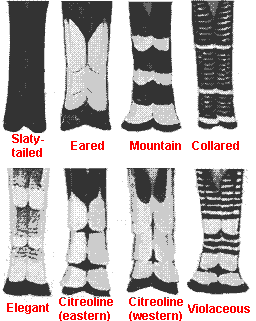 When I need to identify a trogon first I note whether
the belly area is red or yellow, for all Mexican trogon bellies are one or the other. Then
I make a mental snapshot of the barring on the tail's undersides, for it is true that
trogon tails are bar-coded. The sketch at the right shows the tails of males of several
species. Female tails are usually a bit different.
When I need to identify a trogon first I note whether
the belly area is red or yellow, for all Mexican trogon bellies are one or the other. Then
I make a mental snapshot of the barring on the tail's undersides, for it is true that
trogon tails are bar-coded. The sketch at the right shows the tails of males of several
species. Female tails are usually a bit different.
Usually I hear trogons before I see them. They make very
distinctive, low, nasal-sounding, far-carrying, monotonous calls like cow-cow-cow-cow...
However, the Elegant Trogon I'm seeing now deep inside the
sycamore's shadows looks at me for fifteen minutes never making a peep and then in a wink
of the eye silently flutters away. It's strictly by accident that I've seen this species,
for I just happened to be staring at the very spot where it was. It hadn't even crossed my
mind to be looking here for trogons.
DIPPERS
Just opposite to the secretive, silent manner of trogons, all day long, up and down the middle
of the stream, shrilly calling with excited-sounding trills and musical runs, two American
Dippers fly low over the water very often passing right by my sitting rock.
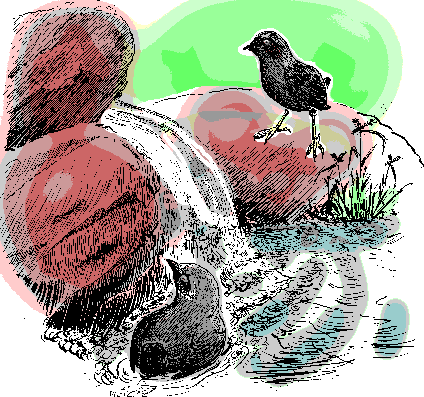
Related to thrushes and wrens, only four dipper species exist in the whole world,
though dippers as a group are found throughout much of the Earth's uplands. They all have
the same roundish, short-tailed, long-legged shape and all live along mountain streams
with cool or cold, clear, flowing water. And the ones I've seen always struck me as
irrepressibly hyperactive.
Dippers eat aquatic larvae of insects, especially those of beetles
and caddisflies, and moths, snails, small fish, and fish eggs. Not only do they work along
the water's edge like sandpipers, they also float atop water like ducks, and, incredibly,
"fly" underwater, and walk along the stream's floor as they forage. They can fly
from below the water's surface into the air, and visa versa, almost as if they simply
don't recognize the boundary between water and air.
Underwater, a movable membrane over the nostrils keeps water out.
When operating abovewater but in the spray of a waterfall, another membrane, the
"nictitating membrane," slides over their eyes. Since the water in mountain
streams is often very cold, the dipper's plumage is well insulated with a thick undercoat
of down. Dippers have preen glands about ten times the size of any other songbird (ducks
aren't songbirds), which provide the oil used for waterproofing their plumage during
preening.
BIRDLIST #4
Here is this stop's Official List:
October 13
latitude 27º25'N, longitude 108º04'W MEXICO: Chihuahua; ±5 kms east and
upstream of Bahuichivo; elev. ±1,650 m (±5,400 feet);
oak-pine forest in canyon
RESIDENCY STATUS:
permanent resident
winter resident
not found in the USA
- Turkey Vulture
- Red-tailed Hawk
- Elegant Trogon
- Northern (Red-shafted) Flicker
- Yellow-bellied Sapsucker
- Gray-breasted (Mexican) Jay
- Steller's Jay
- Common Raven
- American Dipper
- Canyon Wren
- Spotted Wren
- Brown-backed Solitaire
- Ruby-crowned Kinglet
- Yellow-rumped (Audubon's) Warbler
- Painted Redstart
Of the List's two non-U.S. species, the Brown-backed
Solitaire is distributed from approximately here, southern Chihuahua, south
through the Mexican highlands to Honduras. The Spotted Wren is a purely
Mexican bird, found only in oak-pine woods and semi-open dry country from here south
through the uplands to the Isthmus of Tehuantepec. This is a large wren, some eighteen
centimeters long (seven inches). It's closely related to the Cactus Wren of the U.S.'s
southwestern desert.
ROCK IN A STRANGE PLACE
Deciding that after two days of not being seen it's now more or less
safe to camp along the stream, in late afternoon I scout for a camping spot there. Well
hidden behind a tangle of briars, eroded into a vertical rock face about five feet above
the little stream's floodplain, I find a cavity almost too perfect to be true. Perfectly
dry, a little longer than I am, and deep enough for my whole body to fit into, nature
could not have provided a better sleeping platform.
An egg-size rock lies in the hollow's exact center. The rock is of a
curious shape, color, and texture, completely different from the material forming
surrounding cliffs and boulders. Clearly, someone has carried this rock from some distance
away and left it here on purpose.
Has someone just wanted to see if the rock is still here the next
time they drop by and look? Or might this person be generous enough to simply wish to
greet me, the wandering stranger, no matter who I am, no matter what I'm doing, and no
matter when I come here?
I prefer to think it's the latter. I like this concept, and as
darkness comes and I feel snug and safe in my hidden hollow, I come up with this idea:
Someone has sent a greeting to me. Now I pass it along to you, and I
hope that someday when you are properly sensitized and alert, in just such a subtle manner
as has happened here, you will leave a special rock in a perfect place, keeping the
greeting alive.
Go to Stop 5
Return to Trip's Index Page
 One
of the most awe-inspiring railroad tracks in the world runs between Creel and Topolobampo
on the Pacific Coast. With 39 bridges and 87 tunnels, and ranging from 2,417 meters(8,056
feet), to sea level, this stretch of the Chihuahua-Pacifico Railway passes through a
rainbow of ecological zones, from Creel's cold, high-elevation forests of Arizona Pines to
Topoloampo's tropical beaches. In Creel, when I board the train headed westward,
downslope, I ask the conductor for a ticket to the first town surrounded by forest in
which oaks appear among the pines. To my vast surprise, without a single comment or wry
look, the enlightened man simply writes out a ticket reading: Bahuichivo.
One
of the most awe-inspiring railroad tracks in the world runs between Creel and Topolobampo
on the Pacific Coast. With 39 bridges and 87 tunnels, and ranging from 2,417 meters(8,056
feet), to sea level, this stretch of the Chihuahua-Pacifico Railway passes through a
rainbow of ecological zones, from Creel's cold, high-elevation forests of Arizona Pines to
Topoloampo's tropical beaches. In Creel, when I board the train headed westward,
downslope, I ask the conductor for a ticket to the first town surrounded by forest in
which oaks appear among the pines. To my vast surprise, without a single comment or wry
look, the enlightened man simply writes out a ticket reading: Bahuichivo.

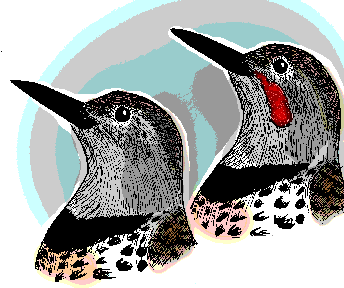
 When I need to identify a trogon first I note whether
the belly area is red or yellow, for all Mexican trogon bellies are one or the other. Then
I make a mental snapshot of the barring on the tail's undersides, for it is true that
trogon tails are bar-coded. The sketch at the right shows the tails of males of several
species. Female tails are usually a bit different.
When I need to identify a trogon first I note whether
the belly area is red or yellow, for all Mexican trogon bellies are one or the other. Then
I make a mental snapshot of the barring on the tail's undersides, for it is true that
trogon tails are bar-coded. The sketch at the right shows the tails of males of several
species. Female tails are usually a bit different.